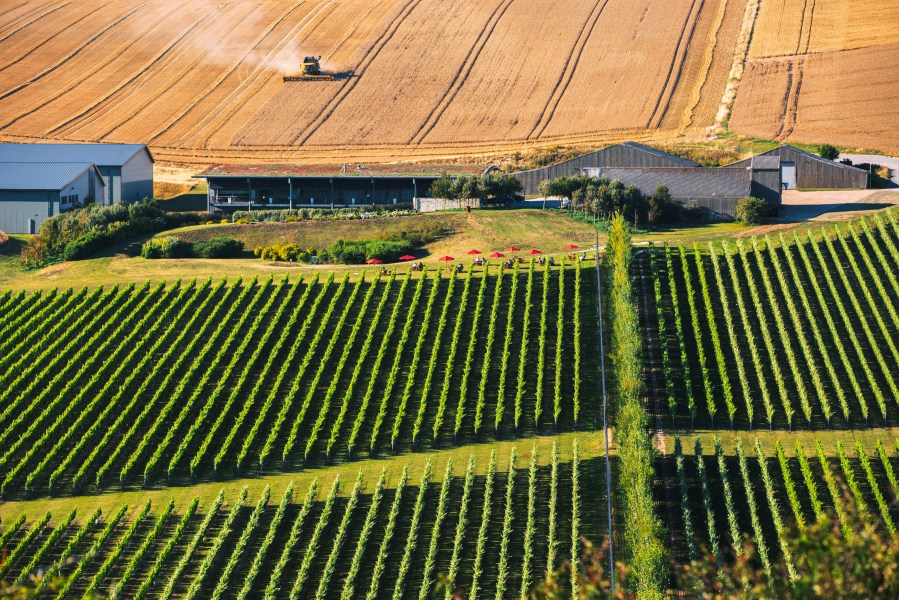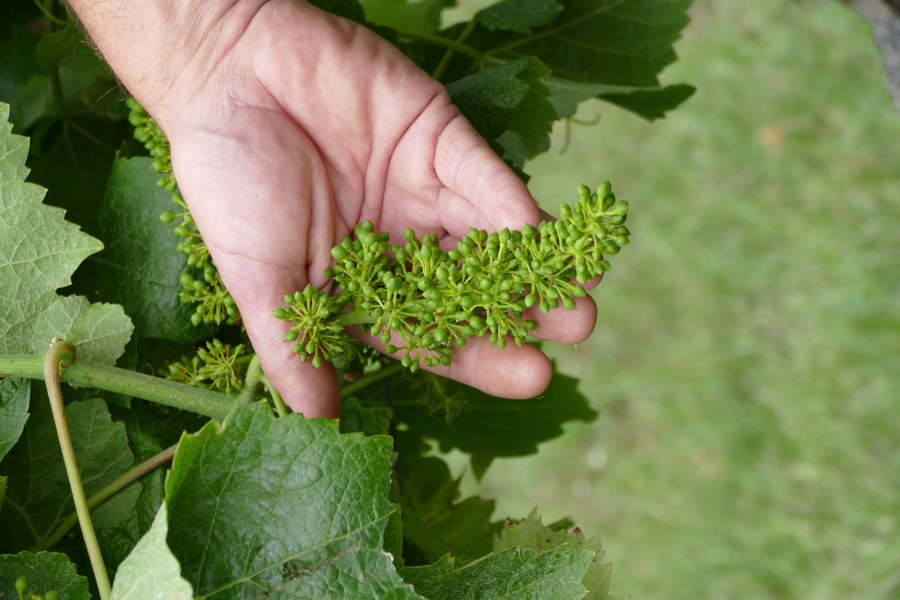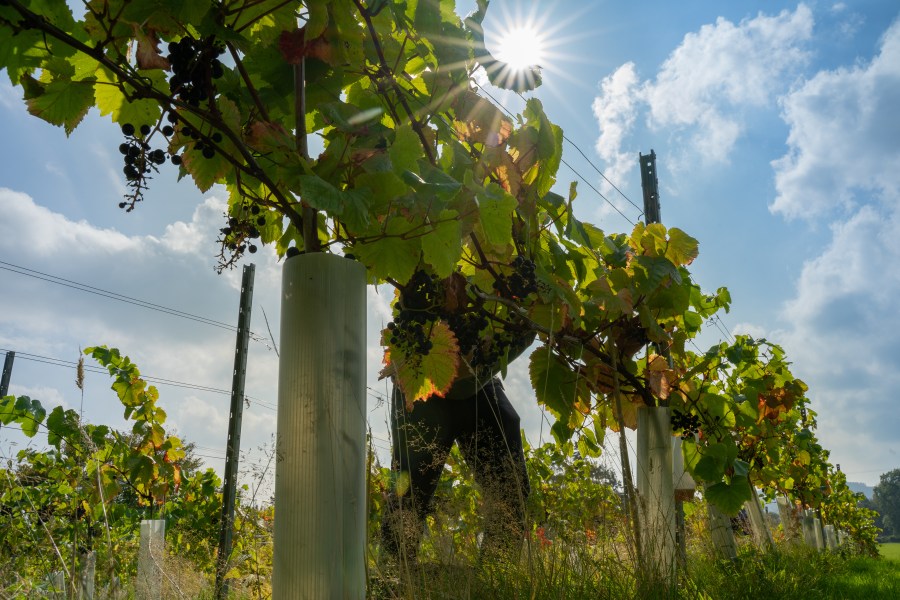In the extreme weather of the summer of 2022, Nyetimber in West Sussex anticipated a bumper harvest. They went on to lead the UK’s largest ever grape harvest with 325 hectares picked.
However, yield is not the same as area. Yield takes into account the volume of grapes produced in a specific zone. Nyetimber may have the largest estate, but more significantly they also saw a record number of grapes from those vineyards, over 1,600 tonnes in total.
Writing regularly about viticulture means that I talk endlessly about balance. Prune your vines, but not too much. Feed your vines, but not too much. The list goes on. And now that a new summer is upon us, we are talking about yields. Surprise, surprise once again balance is the key.
If you want to make a lot of wine, then you need a lot of grapes. But if you want to make a lot of excellent wine, then sometimes you may have to sacrifice some of that abundance in favour of quality. The conditions of 2022 gifted Nyetimber with the opportunity to have both. I wanted to find out more about how vineyards of varying sizes find their own perfect balance. How can yield be optimised without compromising on the taste of the finished product? And what factors are prompting those decisions in 2023?
Charles Martin, the Senior Viticulturalist at VineWorks speaks words of caution. “When dealing with high potential yields in the UK,” Charles said, “the inclement weather we sometimes receive during the season or towards harvest increases the risk of not ripening the crop properly. It is therefore important to find a balance between quality and yield, especially in cold climates. In the UK, matching canopy management with crop loading is essential, and the ultimate goal should be to make informed decisions that lead to a balanced approach.”
To maintain quality whilst optimizing yield, there are a number of options available, depending on how established your vineyard is:
- Vineyard site selection: Choosing an ideal location with suitable soil types, exposure to sunlight, and good air circulation is crucial for maximizing yield potential.
- Grape variety selection: Selecting grape varieties that are well-suited to the local climate and soil conditions is important for achieving optimal yields and quality.
- Viticultural practices: Implementing effective vineyard management techniques such as proper pruning, canopy management, and pest and disease control can contribute to higher yields.
- Technology and innovation: Adopting modern technologies like precision viticulture, weather monitoring systems, and vineyard management software can help optimise vineyard operations and improve overall yield.
- Research and expertise: Collaboration with agricultural researchers, oenologists, and viticulturists can provide valuable insights into best practices, pest management strategies, and vineyard optimisation techniques.
Focus on pruning
Rathfinny Wine Estate, Sussex.
At the Rathfinny Wine Estate in Sussex, they are expecting just under 600 tonnes of grapes this year from 93 hectares of vineyard, although about a third of that area is still under development. Allowing for that puts Rathfinny’s yield at around the UK average.
Rathfinny’s Vineyard Manager and Viticulturist Cameron Roucher told me about their expectations for the coming harvest:
“Yield in the last couple of seasons has been a bit lower than normal due to remedial pruning that we have undertaken. However, this has set up very good carbohydrate stores for this season and is evident in the evenness of growth across the site. This year’s bunch size looks to be some of the largest in recent years.”
A sharp focus on pruning techniques and carefully scheduled nutrition management are the key to Rathfinny’s successful crop. Cameron goes on to tell me that they occasionally green harvest if the crop is looking a little over what they want but “generally this isn’t necessary.” It is unsurprising that the Estate takes such a measured, sustainable approach to yield management. Rathfinny became the first grower-producer of sparkling wine in the world to be awarded B-Corp status earlier this year.
Offering practical advice to other vineyard managers looking to increase their yield, Cameron emphasised the importance of pruning yet again:
“People often lay too many buds down and then push the vine too much, ending up with lots of short shoots. Look at the previous season’s growth and prune to what the vine is capable of. Then it will be able to store carbohydrates better and have greater potential for more buds on the wire and therefore better yields.”

Every year is unique
New Hall Wine Estate, Essex.
The New Hall Wine Estate in Essex was established in 1969 and has 125 acres under vine. These well-established plants allow Andy Hares, the Vineyard and Estate Manager to focus on the “correct balance between yield and quality.” They observe the conditions as the season progresses and undertake remedial actions like green harvesting as necessary.
This season got off to a slow start. “We had a very disappointing spring,” Andy observes. “It felt long, cold and damp. But the hot spell we had in June brought the vines back on schedule.”
The estate found itself in one of the driest places in the country during last summer’s heatwave which made a significant dent in their yield. However, the situation looks much improved already in 2023. Discussing the issue in the second week of July Andy remarked that there had already been more rainfall than in the whole of the month the year previous.
Plus a settled spell during flowering helped that process along. There was no great difference between daytime and night-time temperatures resulting in very large inflorescences and excellent bunch sizes – unusually large, in fact, for certain varieties like Pinot Noir.
Work at New Hall is now focused on trimming the vines and then moving on to leaf stripping to manage the canopy for optimum ripeness. They are also coming to the end of their preventative fungicide program as the dry conditions mean they tend to harvest quite early – usually starting in early September.
This year their autumn program will be transformed as they have purchased a new harvesting machine. Not having to plan for the organisation of picking teams in advance means that they can leave the fruit hanging for as long as they dare. And they will enjoy a less intense workload on actual harvest days.
Andy advises that vineyard managers should look to their winemakers for guidance on decision-making around yield. The process and the wine styles required will inform how to find that balance between quality and quantity. He stresses that communication with producers or grape buyers is key to managing your yield in the correct way for your business.

Quality, not compromise
Gusbourne, Kent.
Speaking to Jonathan White, the Marketing Director for Gusbourne at Ashford in Kent, it is clear that they are not willing to push for a higher yield:
“We have purposely selected lower-yielding clones (predominantly from Burgundy) to create fuller and more flavoursome grapes,” Jonathan tells me. “Most of our vineyards are also mature by English standards, so this too has a reducing effect on yields. We conduct regular green harvests throughout the growing season to thin the crop and maintain the health of our vines too (a crucial factor for us as we specifically produce only vintage wines and so require our vineyards to create fantastic fruit for us each and every year).”
That laser focus on grape quality has been reaping rewards. Gusbourne’s Blanc de Blancs 2018 picking up a Best in Show award at the 2023 Decanter World Wine Awards. The sparkling wine, made with 100% Chardonnay, was described by the judges as having “remarkable assurance and accomplishment.”
Yields are not fixed year upon year. And there is a limit to how far human intervention can affect the amount of fruit a vine will produce in a certain season. Far more influential are the effects of the weather, as we have seen in the great fluctuations in yield over recent years. Stephen Skelton’s incredibly helpful vineyard production data for Great Britain shows an average yield of nearly 46 hectolitres per hectare in the long hot summer of 2018, compared with a figure of just over 23.5 hectolitres per hectare from the 2021 harvest, described by some commentators as an “exceptionally difficult” vintage.
Gusbourne take steps to manage the yield from their 90 hectares of vineyards depending on the style of wine they are producing. “When making still wines, for example,” Jonathan explains, “we drop additional fruit throughout the growing season to ensure full richness and concentration is found in the remaining grapes. Our Blanc de Blancs is 100% Chardonnay and our Blanc de Noirs is 100% Pinot Noir. Some growing seasons also favour one grape over another!”
Flowering has been absolutely immense
Sandridge Barton, Devon.
Sandridge Barton, the home of Sharpham Wine along the River Dart in Devon, have been growing since 1981. They are in the process of expanding their plantings, bringing them currently up to about 40 acres. While in ‘average’ years the vineyards tend to produce around the average of 2 to 4 tonnes per acre, the CEO and Chief Winemaker, Duncan Schwab, is expecting incredible things from the 2023 yield.
“This year flowering has been absolutely immense,” Duncan smiles. “We’re hoping to get around 90+ tonnes from our 25 acres of actual cropping acreage – over 3.5 tonnes an acre.
“Flowering was about two weeks earlier than usual and we didn’t have any rain around the pollination period. I usually go around and tap the flower florets when they finish flowering to see the set. Normally I would get about 25% that would fall off in my hand. This year we didn’t get anything which means that the set is pretty much perfect. It’s a good indicator – but a slight worry in that we now need the good weather to ripen up a large harvest.”
They are now indulging in a spot of green harvesting so that the vines can put all of their energy into smaller numbers of viable bunches for ripening. The Sandridge Barton team are taking the bunches back to two per cane where some are now throwing out three or four.
“It’s always nice to let the vines do what they need to do and then make decisions after flowering,” Duncan tells me. “Then you’re one step ahead of the game. At this time of the year, before the vine puts its energy into the actual crop we can dictate what it’s going to concentrate on. A lot of that work is based on forecasting weather conditions.
“Quality always outstrips quantity as far as we’re concerned. We’ve spent a lot of energy on the winery side to make sure we’ve got sorting tables and tank control systems in place so it’s all lined up with quality. But at the same time, the bank manager is always happier when the quality is there along with the quantity!”
Trying to establish a solid foundation for their future yield, Duncan is also leading the process of removing all the flowering clusters from their three-year-old plantings. They are holding a good crop, but he prefers that they put their energy into their roots in preparation for a bountiful harvest next year.
As an interesting aside, the Sandridge Barton Madeleine Angevine grapes got sunburn on the skins for the first time in 2022. The vines went into self-preservation mode and shut down because of the heat, causing the final harvest to contain more acid and less sugar. So despite having a generally fantastic vintage, they observed that the cool climate varieties had real trouble with the heatwave. They had (typically) just planted more Madeleine as Duncan really likes its floral aromatic qualities and it had previously been “a real banker in the South West.” However, the difficulties experienced by early cropping varieties like Madeleine and Pinot Noir Precose in the exceptional weather has made decisions on future plantings less clear-cut. Anecdotally this suggests that climate change may make varieties like these less viable in Devon in the future.
A young vineyard finds its way
Whinyard Rocks, Powys.
Not every vineyard is long established or has the benefit of a team with decades of experience behind them. I wanted to find out more about how a smaller, younger business approaches the question of yield. Whinyard Rocks are a new low-intervention vineyard in Powys.
“There’s no real need for yield forecasts given our small scale,” said owner James Kinsey-Jones. “Our yield is naturally inhibited by our low-intervention approach, as we don’t use a lot of chemical input – and our site is very westerly and high, so it’s not necessarily the highest yielding location anyway. We are right at the edge of what’s viable, so we have planted lots of early ripening varieties to help us out.”
With many new plantings, production is steadily increasing year on year. Now in their third commercial season, James’ focus is on creating wines that represent the local environment. As a small producer, the identity of the vineyard and making unique products is the most important thing to establishing themselves in the marketplace. Their geography means that they harvest a few weeks later than other UK growers, giving the grapes more time on the vine to develop their aromatic profile.
Their delayed growing season also helps them to avoid the perils of spring frosts to a degree. The inflorescences looked healthy and full initially, although it is uncertain how much damage recent exposure to wind and rain at their altitude may have caused to the flowers. At the time of writing, they are waiting to see how well the fruit ultimately sets but they are feeling hopeful.
A new vineyard manager without an industry background, James has found a great deal of support through training funded by the Welsh Government’s Welsh Wine Special Interest group. Whinyard Rocks are undergoing a learning process about how their new growing environment actually works throughout the year as their vines come to maturity. The question of yield will come into sharper focus for them later.

©Mat Price




